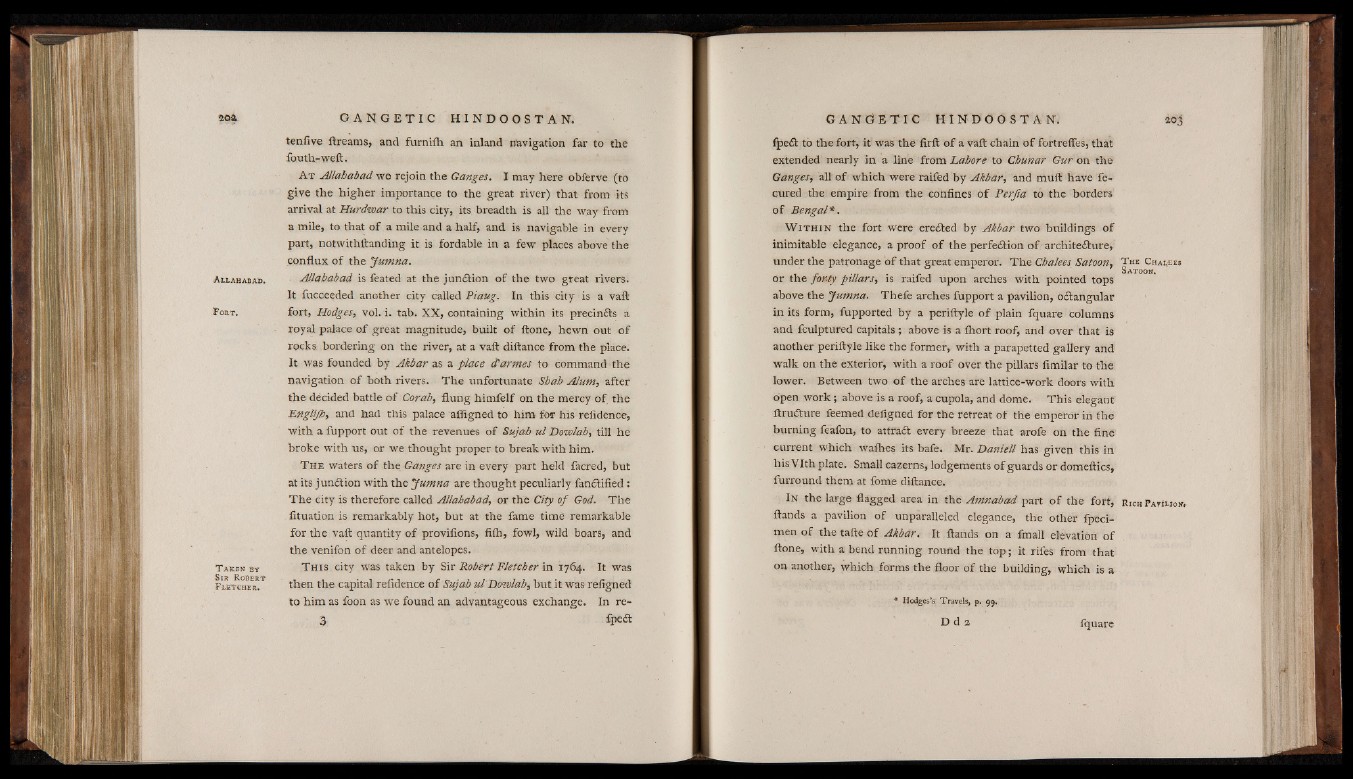
A l l a h a b a d .
ÌFort.
T aken b y
S ir Robert
F letcher.
tenfive ftreams, and furniih an inland navigation far to the
fouth-weft.
At Allahabad we rejoin the Ganges. I may here obferve (to
give the higher importance to the great river) that from its
arrival at Hurdwar to this city, its breadth is all the way from
a mile, to that of a mile and a half, and is navigable in every
part, notwithstanding it is fordable in a few places above the
conflux of the Jumna.
Allahabad is feated at the junition o f the two great rivers.
It Succeeded another city called Piaug. In this city is a vaft
fort, Hodges, vol. i. tab. XX, containing within its precincts a
royal palace o f great magnitude, built of ftone, hewn out of
rocks bordering on the river, at a vaft diftance from the place.
It was founded by Akbar as a place cTarmes to command the
navigation o f both rivers. The unfortunate Shah Alum, after
the decided battle of Corah, flung himfelf on the mercy o f the
Englijh, and had this palace afligned to him for his refidence,
with a fupport out of the revenues of Sujah ul Dowlah, till he
broke with us, or we thought proper to break with him.
T h e waters o f the Ganges are in every part held facred, but
at its junction with the Jumna are thought peculiarly fancftified:
The city is therefore called Allahabad, or the City of God. The
iituation is remarkably hot, but at the fame time remarkable
for the vaft quantity o f provifions, filh, fowl, wild boars, and
the venifon o f deer and antelopes.
T his city was taken by Sir Robert Fletcher in 1764. It was
then the capital refidence of Sujah ul'Dowlah, but it was refigned
to him as foon as we fouHd an advantageous exchange. In re-
& fpe&
fpe£t tò the fort, it was thè firft of a vaft chain of fortreffes, that
extended nearly in a line from Lahore to Chunar Gur on the
Ganges, all o f which were raifed by Akbar, and muft have fe-
cured the empire from the confines o f Perjia to the borders
o f Bengal*.
W i t h i n the fort were erecfted by Akbar two buildings o f
inimitable elegance, a proof o f the perfection o f architecture,
under the patronage of that great emperor. The r . . . - - Cbalees Satoon, The Chaise, S a to o n . or the forty pillars, is raifed upon arches with pointed tops
above the Jumna. Thefe arches fupport a pavilion, octangular
in its form, fupported by a periftyle o f plain fquare columns
and fculptured capitals ; above is a ihort roof, and over that is
another periftyle like the former, with a parapetted gallery and
walk on the exterior, with a roof over the pillars fimilar to the
lower. Between two o f thè arches are lattice-work doors with
open work ; above is a roof, a cupola, and dome. This elegant
ftructure feemed defigned for the retreat o f the emperor in the
burning feafon, to attract every breeze that arofe on the fine
current which Waihes its bafe. Mr. Danieli has given this in
his Vlth plate. Small eazerns, lodgements o f guards or domeftics,
furround them at fome diftance.
In the large flagged area in the Amnabad part o f the fort, Rich Pavilion .
ftands a pavilion of unparalleled elegance, the other fpeci-
men of the tafte of Akbar. It ftands on a fmall elevation of
ftone, with a bend running round the top; it rifes from that
on another, which forms the floor o f the building, which is a
* Hodges’s Travels, p. 99,